Color-stable botanicals can transform your handcrafted soap into naturally vibrant creations. You'll get the best results by using proven ingredients like spirulina for blue-green and turmeric for yellow, keeping concentrations at 5% or less of total soap weight. Pre-infuse your botanicals in carrier oils for 2-3 weeks, strain thoroughly, and store in dark containers. Monitor temperature and pH levels during processing. The journey to mastering natural soap colorants reveals endless creative possibilities.
Understanding Color-Stable Botanical Sources
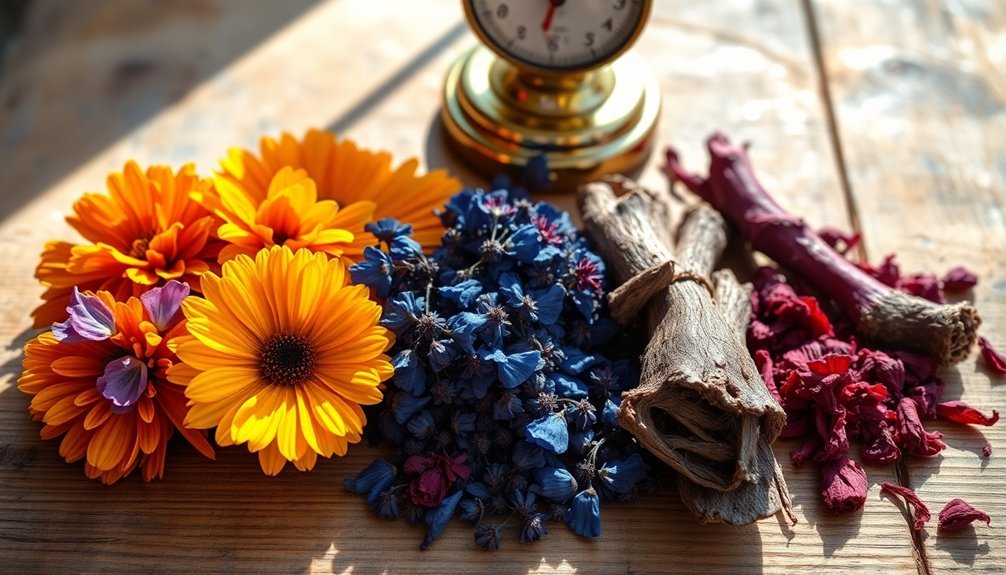
When crafting natural soaps, selecting the right color-stable botanicals can make the difference between vibrant, lasting hues and disappointing, faded results.
You'll find that certain plant-derived ingredients maintain their color integrity throughout your soap's lifespan, making them invaluable for consistent results.
To achieve reliable color in your soap, you'll want to work with proven botanicals like spirulina for blue-green tones and turmeric for yellow shades.
Natural colorants like spirulina and turmeric offer soap makers consistent, vibrant hues when incorporated properly into handcrafted soap formulations.
Remember to keep your colorant concentration at or below 5% of your total soap weight to guarantee ideal results.
You'll need to test small batches first, as different soap-making methods can affect how these botanicals perform.
Always source high-quality botanical powders – their purity directly impacts your final color outcomes.
Essential Preparation Techniques for Raw Materials
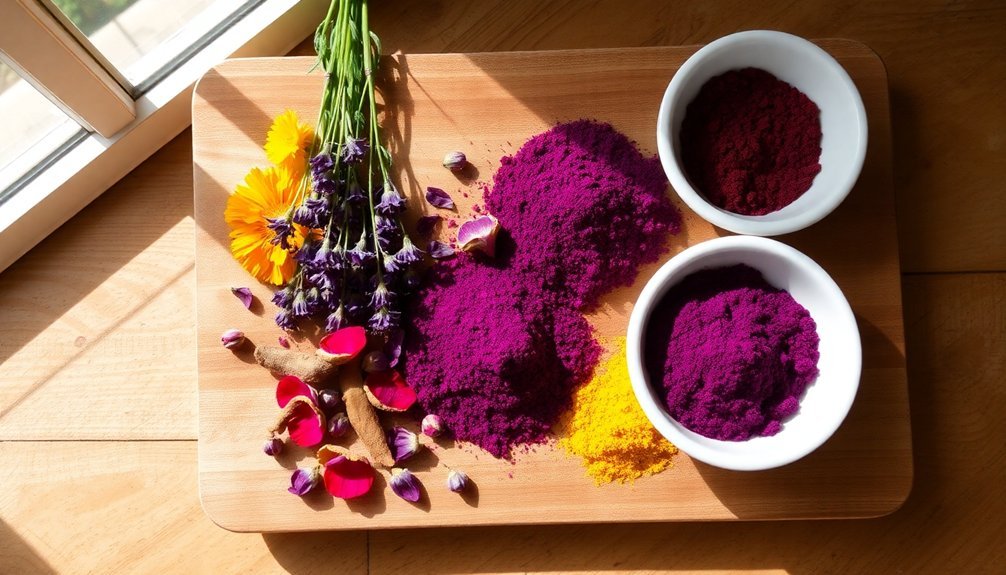
You'll need to strain your botanical plant matter through a fine-mesh sieve to remove any unwanted debris before incorporating it into your soap making process.
Pre-infusing your natural colorants in a carrier oil for 2-3 weeks helps extract the maximum color potential while ensuring even distribution throughout your final product.
For best results, strain your infused oils twice through cheesecloth to remove any remaining plant particles that could affect the soap's texture.
Straining Botanical Plant Matter
Three critical steps in botanical soap-making involve proper straining techniques, which prevent unwanted particles from affecting your final product.
When you're straining botanical plant matter, you'll need to work quickly while the infusion is still warm, but not scalding, to maintain the natural properties and colors.
Using the right tools, like fine mesh strainers or cheesecloth, guarantees your naturally colored soaps achieve that professional, smooth finish.
- Select your straining method based on your botanical material's size – use cheesecloth for finer particles and mesh strainers for coarser matter
- Document the amount of plant matter and liquid strained to maintain consistency in future batches
- Complete the straining process immediately after steeping to prevent over-extraction and unwanted color changes
Pre-Infusing Natural Colorants
After mastering proper straining techniques, successful natural soap coloring begins with pre-infusion.
When pre-infusing natural colorants, you'll want to soak your botanical materials in warm or hot liquid, such as water or oil, to maximize color extraction and beneficial properties.
To achieve the best results in your soap making, keep your colorant amounts to no more than 5% of your total soap weight. This guarantees vibrant colors without compromising your formula.
You'll find it helpful to test small batches first, as colors can vary depending on whether you're using cold process, hot process, or melt-and-pour methods.
Don't forget to keep detailed records of your pre-infusion process.
Optimal Usage Rates and Color Intensity
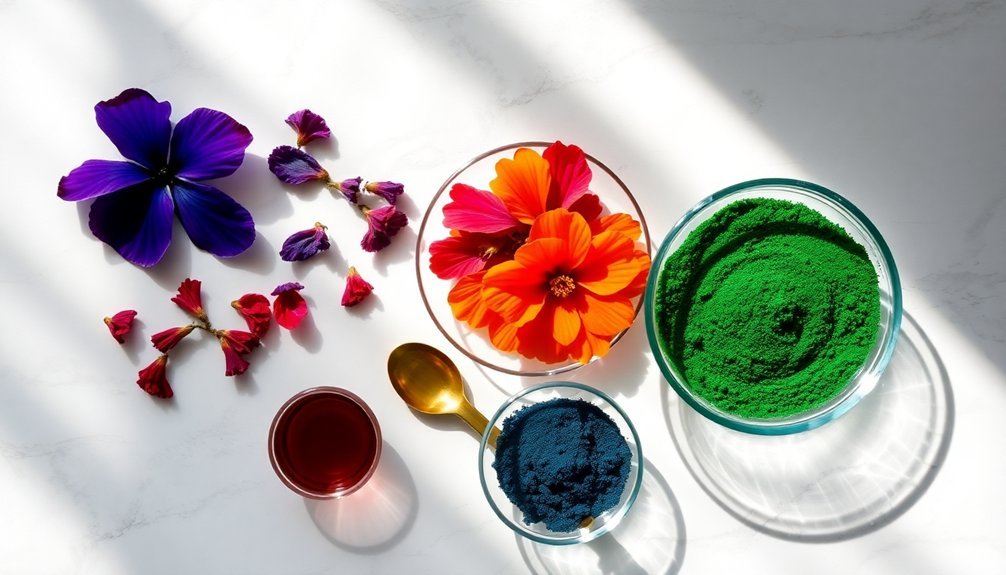
To achieve reliable color results in your botanical soap formulations, you'll need to start with small test batches at 1-2% concentration before gradually increasing to the maximum 5% threshold.
You can intensify or modify hues by combining compatible natural pigments, such as mixing yellow calendula with blue indigo for various green shades.
When blending multiple botanicals, keep your total colorant percentage within the 5% limit to maintain proper saponification while ensuring the most stable, long-lasting colors in your final product.
Testing Color Saturation Limits
When crafting naturally colored soaps, determining the ideal usage rates for botanical colorants requires systematic testing to achieve desired color intensity.
You'll need to experiment with different percentages, keeping in mind the 5% maximum threshold for best results. Natural colorants like madder root can vary greatly in their saturation potential across different soap-making methods.
To effectively test color saturation limits:
- Start with small test batches at 1%, 2.5%, and 5% concentrations to observe how each botanical performs.
- Document your results, including any color changes during curing and exposure to light.
- Test each colorant in your preferred soap-making method, as performance can differ between cold process, hot process, and melt-and-pour techniques.
These controlled experiments will help you develop reliable formulas for consistent, vibrant results in your finished soaps.
Natural Pigment Blending Guidelines
Building upon your color saturation testing experience, successful natural pigment blending requires understanding both individual and combined usage rates for ideal results.
When working with natural soap colorants, you'll need to stay within the 5% maximum usage threshold of your total soap weight, even when combining multiple pigments.
You'll find that each soap-making method affects color intensity differently, so you should test small batches first.
Keep detailed records of your blending experiments, noting how different natural colorants interact in cold process versus other methods.
Watch out for ingredients like turmeric that might stain skin if overused.
To achieve consistent results, document your successful combinations and their specific ratios.
This systematic approach will help you develop reliable natural colorant blends that perform predictably in your soap formulations.
Temperature Impact on Natural Pigments
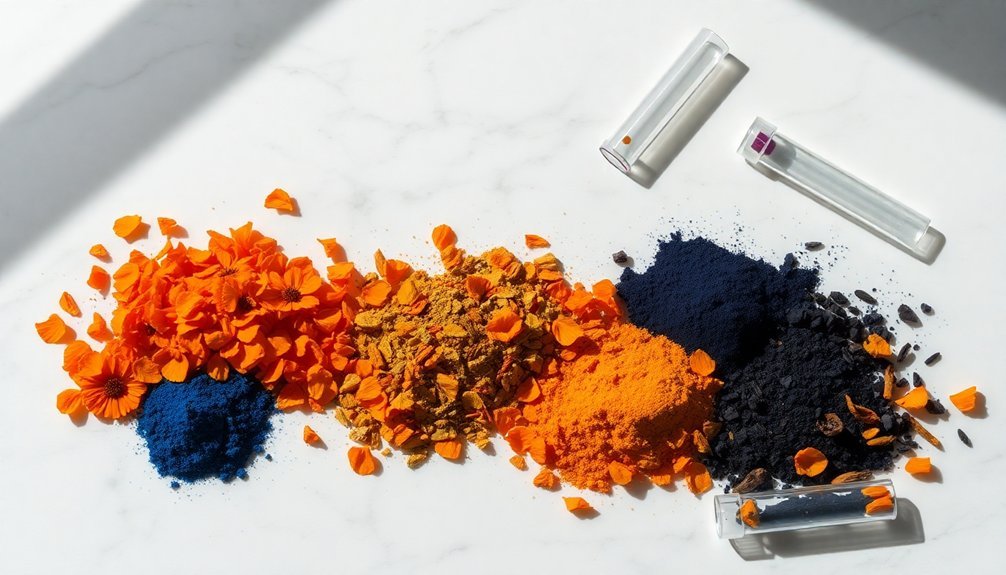
Since temperature plays a significant role in natural soap coloring, understanding its effects on botanical pigments can make or break your final product.
When crafting castile soap, you'll need to carefully monitor heat levels as they directly influence your colorants' stability and vibrancy. Some natural pigments intensify with heat, while others fade or transform unexpectedly.
To achieve consistent results with natural colorants, follow these essential temperature guidelines:
Follow key temperature guidelines when working with natural colorants to ensure your soaps maintain consistent, predictable results.
- Test small batches at different temperatures to document how your chosen pigments respond.
- Monitor heat carefully during saponification, as temperature fluctuations can cause color inconsistencies.
- Consider that heat-sensitive botanicals like beet root powder may require lower processing temperatures, while others like turmeric become more vibrant with increased heat.
Always conduct preliminary tests to understand how your specific botanical colorants behave under various temperature conditions.
Ph Considerations for Long-Lasting Colors
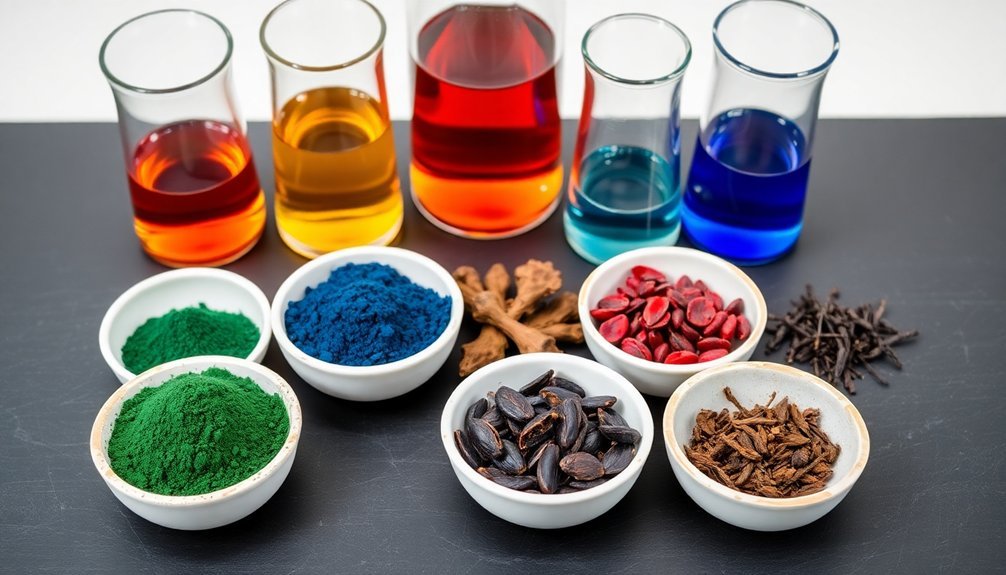
Understanding pH levels is essential for maintaining vibrant botanical colors in your soap. You'll find that lower pH environments help preserve natural colorants better, which is particularly important when working with liquid soap formulations.
When you're using botanicals like beet root powder, you'll need to pay special attention to pH balance, as it tends to fade quickly in alkaline conditions. In contrast, turmeric shows remarkable stability across different pH levels.
To achieve the best results, add your natural colorants at trace during the cold-process method. This timing helps shield the botanicals from harsh saponification effects.
You can optimize your color stability by testing small batches at varying pH levels. Remember to store your finished soaps in a cool, dark place to protect those carefully crafted hues from premature fading.
Storage Methods for Color Preservation
To maintain the vibrancy of your raw botanicals, proper storage plays an essential role in preserving their natural colors.
Whether you're working with delicate flower petals or activated charcoal, storing your ingredients correctly will guarantee they retain their vibrant hues for your soap-making projects.
Choose dark-colored glass jars or opaque containers to shield your botanicals from harmful UV rays, and always keep them in a cool, dry location with consistent temperature.
You'll want to monitor your stored ingredients regularly for any signs of deterioration.
- Create a labeling system that includes purchase dates and expected shelf life
- Use airtight containers to prevent moisture and oxidation
- Check stored botanicals monthly for signs of mold or color changes
Remember to discard any compromised materials immediately to maintain the quality of your soap-making ingredients.
Frequently Asked Questions
What Herbs Are Good for Coloring Soap?
You'll get vibrant colors using madder root for red, turmeric for yellow, spirulina for blue-green, alkanet root for purple, and beet root for pink. These natural herbs create beautiful shades in your soap.
What Botanicals Can You Put in Soap?
You can add spirulina for blue-green, turmeric for yellow, madder root for red, beetroot for pink, and annatto seeds for orange. These botanicals won't just color your soap but also provide natural benefits.
What Flowers Are Good for Soap Making?
You'll get great results using calendula, chamomile, lavender, hibiscus, and rose petals in your soaps. They'll add natural colors, beneficial properties for your skin, and lovely fragrances to your handcrafted creations.
Is It Safe to Put Food Coloring in Soap?
You shouldn't use food coloring in soap as it's not skin-safe and can cause irritation. It'll also fade quickly and may react unpredictably during soap making. Instead, stick to soap-specific or natural colorants.
In Summary
With proper understanding of color-stable botanicals, you'll create vibrant, long-lasting natural soaps. Remember to select pH-appropriate materials, maintain ideal temperatures during processing, and store your raw ingredients correctly. By following recommended usage rates and preparation techniques, you'll achieve consistent, beautiful results. Don't forget that each botanical source behaves differently – document your successes and keep refining your natural colorant methods.





Leave a Reply